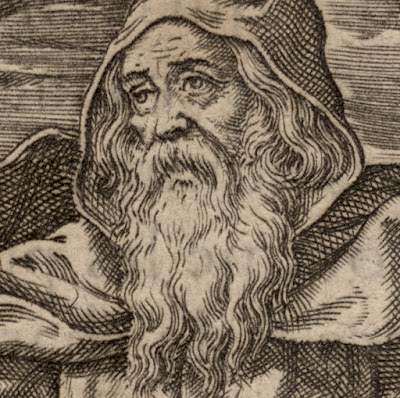Jules Jacquemart (aka Jules Ferdinand Jacquemart)
(1837–80)
Plate 41: “Jatt
de Crystal de Roche” [EL] or “Drageoir de Cristal de Roche” [BM], 1864, from
the series “Gemmes et Joyaux de la Couronne au Musée du Louvre”, printed by
Auguste Delâtre (1822–1907) and published by Henry Barbet de Jouy
Etching with
plate/surface tone on laid paper with full margins (as published).
Size: (sheet)
54.5 x 37 cm; (plate) 38.8 x 28 cm; (image borderline) 34 x 26.6 cm
Inscribed
within the image (lower centre) “Jules Jacquemart delin. & sculp.”
Lettered above
the image (upper left corner) “PL. 41”; (upper centre) “MUSÉE DU LOUVRE.”
Lettered below
the image (centre) “Imp. Delȃtre, Paris.”
To see the
complete series see Elizabeth Legge gallery: http://www.leggeprints.com/jacquemart/index.htm
The British
Museum offers the following description of this print:
"A rock
crystal cup with scalloped rim. 1864 Etching, with surface tone." (http://www.britishmuseum.org/research/collection_online/collection_object_details.aspx?objectId=3533107&partId=1&searchText=Jules+Jacquemart+crystal&page=1)
Gonse 146.II
(Gonse, Louis, “Jules Jacquemart”, Gazette des Beaux-Arts)
Condition:
large, superb impression in near pristine condition (i.e. there are no tears,
holes, abrasions, folds or foxing, but there are a couple of small spots) with
generous margins.
I am selling
this remarkable illustration of a rock crystal cup from the Louvre collection
for AU$118 (currently US$87.75/EUR82.62/GBP70.40 at the time of this listing)
including postage and handling to anywhere in the world. If you are interested
in purchasing this large etching of the highest order of technical skill,
please contact me (oz_jim@printsandprinciples.com) and I will send you a PayPal
invoice to make the payment easy.
This print has been sold
This is the
third illustration by Jacquemart that I have posted of objects in the Louvre collection. This particular image is probably the ultimate display
of virtuosity that one can find. It is a standalone visual statement of the
remarkable skill of the top illustrators from the 19th century.
Jacquemart is arguably
the finest illustrator of still life objects in
terms of using only line (i.e. without blocks of tone or colour) to render the
subtle differences of surface texture, opacity and sheen separating crystal,
stone and metal. Not only was Jacquemart able to convincingly represent each
material, but he was also able to suggest the delicacy and the weight of each object.
To fully
appreciate what makes an artist like Jacquemart a true master of his craft, one
only has to examine the way that he has drawn the rim of this cup and see how
he has phrased the strength of the line from strong and dark in the foreground to
delicate and faint further back. Moreover, even within each scalloped curve, he
has varied the strength of the line.




















































